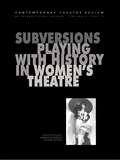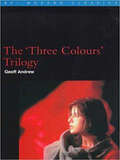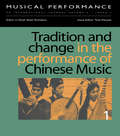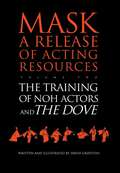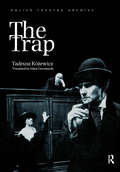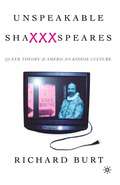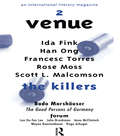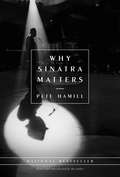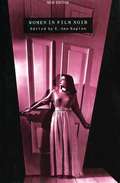- Table View
- List View
Subversions
by Erika Block Gabriele Griffin Julie WilkinsonFirst Published in 1998. Routledge is an imprint of Taylor & Francis, an informa company.
Subversions
by Erika Block Gabriele Griffin Julie WilkinsonFirst Published in 1998. Routledge is an imprint of Taylor & Francis, an informa company.
Theory and Practice of Classic Detective Fiction (Contributions to the Study of Popular Culture)
by Jerome H. Delamater Ruth PrigozyCombining theoretical and practical approaches, this collection of essays explores classic detective fiction from a variety of contemporary viewpoints. Among the diverse perspectives are those which interrogate the way the genre reflects important social and cultural attitudes, contributes to a reader's ability to adapt to the challenges of daily life, and provides alternate takes on the role of the detective as an investigator and arbiter of truth.Part I looks at the nature of and the audience for detective fiction, as well as at the genre as a literary form. This section includes an inquiry into the role of the detective; an application of object-relations psychology to the genre; and analyses of recent literary criticism positing that traditional detective fiction contained the seeds of its own subversion. Part II applies a variety of theoretical positions to Agatha Christie and her heirs in the British ratiocinative tradition. A concluding essay positions the genre within the middle-class traditions of the novel since its inception in the eighteenth century. Of interest to all scholars and students of detective fiction and British popular culture.
The 'Three Colours' Trilogy (BFI Film Classics)
by Geoff AndrewThis appreciative account of the 'Three Colours' trilogy communicates the power and imagery of the films, and demonstrates how Kieslowski's art is brought to bear in their moving renditions of the lives of its characters. An interview with Kieslowsi shortly before his death concludes this tribute.
Tradition & Change Performance (Musical Performance Ser. #Vols. 2, Pts. 2.)
by TsaoFirst published in 1998. Routledge is an imprint of Taylor & Francis, an informa company.
Tradition & Change Performance
by TsaoFirst published in 1998. Routledge is an imprint of Taylor & Francis, an informa company.
The Training of Noh Actors and The Dove (Mask - A Release Of Acting Resources Ser. #Vol. 2)
by David GriffithsFirst Published in 1998. Routledge is an imprint of Taylor & Francis, an informa company.
The Training of Noh Actors and The Dove
by David GriffithsFirst Published in 1998. Routledge is an imprint of Taylor & Francis, an informa company.
The Trap
by Tadeusz RosewiczFirst Published in 1998. Routledge is an imprint of Taylor & Francis, an informa company.
The Trap
by Tadeusz RosewiczFirst Published in 1998. Routledge is an imprint of Taylor & Francis, an informa company.
Understanding Animation
by Paul WellsFirst Published in 1998. Routledge is an imprint of Taylor & Francis, an informa company.
Understanding Animation
by Paul WellsFirst Published in 1998. Routledge is an imprint of Taylor & Francis, an informa company.
Unspeakable ShaXXXspeares, Revised Edition: Queer Theory and American Kiddie Culture
by NA NAUnspeakable ShaXXXspeares is a savvy look at the wide range of adaptations, spin-offs, and citations of Shakespeare's plays in 1990s popular culture. What does it say about our culture when Shakespearean references turn up in television episodes of The Brady Bunch and Gilligan's Island, films such as In and Out and My Own Private Idaho, and hardcore porn adaptations of Hamlet and Romeo and Juliet? Burt reads the reception of these often quite bad replays in relation to contemporary youth culture and the "queering" of Shakespeare.
Vale's Technique of Screen and Television Writing
by Eugene ValeVale's Technique of Screen and Television Writing is an updated and expanded edition of a valuable guide to writing for film and television. Mr. Vale takes the aspiring writer through every phase of a film's development, from the original concept to the final shooting script. Teachers of the craft as well as writers and directors have acclaimed it as one of the best books ever written on how to write a screenplay. This book combines practical advice for the aspiring or established writer with a lucid overview of the unique features of this most contemporary art form, distinguishing film and video from other media and other kinds of storytelling. It teaches the reader to think in terms of the camera and gives practical advice on the realities of filmmaking. At the same time, Vale, who began his own career as a scriptwriter for the great French director Jean Renoir, provides a solid grounding in the history of drama from the Classical Greek theater through the great cinematic works of the twentieth century. Both philosophical and pragmatic, this is a very readable book for students and active professionals who want to improve their writing skills, and for film enthusiasts interested in knowing more about what they see on the screen.Mr. Vale is that rare combination, a practitioner of great experience who can offer a lucid explanation of his craft.Eugene Vale was born in Switzerland and began his career in France in the 1930s. He was an award-winning novelist, film and TV scriptwriter and teacher, whose works include the bestselling novel The Thirteenth Apostle and the scripts for Francis of Assisi, The Bridge of San Luis Rey, and The Second Face. He also worked in many other areas of the motion picture industry, including directing, producing, cutting, distribution and finance. His archives are held by Boston University and University of Southern California. Mr. Vale died in 1997, shortly after he completed the updated version of this handbook.
Vale's Technique of Screen and Television Writing
by Eugene ValeVale's Technique of Screen and Television Writing is an updated and expanded edition of a valuable guide to writing for film and television. Mr. Vale takes the aspiring writer through every phase of a film's development, from the original concept to the final shooting script. Teachers of the craft as well as writers and directors have acclaimed it as one of the best books ever written on how to write a screenplay. This book combines practical advice for the aspiring or established writer with a lucid overview of the unique features of this most contemporary art form, distinguishing film and video from other media and other kinds of storytelling. It teaches the reader to think in terms of the camera and gives practical advice on the realities of filmmaking. At the same time, Vale, who began his own career as a scriptwriter for the great French director Jean Renoir, provides a solid grounding in the history of drama from the Classical Greek theater through the great cinematic works of the twentieth century. Both philosophical and pragmatic, this is a very readable book for students and active professionals who want to improve their writing skills, and for film enthusiasts interested in knowing more about what they see on the screen.Mr. Vale is that rare combination, a practitioner of great experience who can offer a lucid explanation of his craft.Eugene Vale was born in Switzerland and began his career in France in the 1930s. He was an award-winning novelist, film and TV scriptwriter and teacher, whose works include the bestselling novel The Thirteenth Apostle and the scripts for Francis of Assisi, The Bridge of San Luis Rey, and The Second Face. He also worked in many other areas of the motion picture industry, including directing, producing, cutting, distribution and finance. His archives are held by Boston University and University of Southern California. Mr. Vale died in 1997, shortly after he completed the updated version of this handbook.
Venue 2
by BrenkmanFirst Published in 1998. Routledge is an imprint of Taylor & Francis, an informa company.
Venue 2
by BrenkmanFirst Published in 1998. Routledge is an imprint of Taylor & Francis, an informa company.
Visions of the Past: The Challenge of Film to Our Idea of History
by Robert A. RosenstoneCan filmed history measure up to written history? What happens to history when it is recorded in images, rather than words? Can images convey ideas and information that lie beyond words? Taking on these timely questions, Robert Rosenstone pioneers a new direction in the relationship between history and film. Rosenstone moves beyond traditional approaches, which examine the history of film as art and industry, or view films as texts reflecting their specific cultural contexts. This essay collection makes a radical venture into the investigation of a new concern: how a visual medium, subject to the conventions of drama and fiction, might be used as a serious vehicle for thinking about our relationship with the past. Rosenstone looks at history films in a way that forces us to reconceptualize what we mean by "history." He explores the innovative strategies of films made in Africa, Latin America, Germany, and other parts of the world. He journeys into the history of film in a wide range of cultures, and expertly traces the contours of the postmodern historical film. In essays on specific films, including Reds, JFK, and Sans Soleil, he considers such issues as the relationship between fact and film and the documentary as visionary truth. Theorists have for some time been calling our attention to the epistemological and literary limitations of traditional history. The first sustained defense of film as a way of thinking historically, this book takes us beyond those limitations.
What's So Funny?: Sketches from My Life (Choreography and Dance Studies Series)
by Lotte GoslarFirst Published in 1998. Routledge is an imprint of Taylor & Francis, an informa company.
What's So Funny?: Sketches from My Life (Choreography and Dance Studies Series #Vol. 15)
by Lotte GoslarFirst Published in 1998. Routledge is an imprint of Taylor & Francis, an informa company.
Whole World of Music: A Henry Cowell Symposium (Contemporary Music Studies)
by David NichollsFirst Published in 1998. Routledge is an imprint of Taylor & Francis, an informa company.
Whole World of Music: A Henry Cowell Symposium (Contemporary Music Studies)
by David NichollsFirst Published in 1998. Routledge is an imprint of Taylor & Francis, an informa company.
Why Sinatra Matters (Basic Ser.)
by Pete HamillIn this unique homage to an American icon, journalist and award-winning author Pete Hamill evokes the essence of Sinatra--examining his art and his legend from the inside, as only a friend of many years could do. Shaped by Prohibition, the Depression, and war, Francis Albert Sinatra became the troubadour of urban loneliness. With his songs, he enabled millions of others to tell their own stories, providing an entire generation with a sense of tradition and pride belonging distinctly to them.
Withnail and I: The Screenplay (Bloomsbury Film Classics Ser.)
by Bruce RobinsonBruce Robinson's celebrated cult comedy.This original screenplay is the sourcebook for these ubiquitous quotes about Withnail and his unnamed house-mate "I" (or "Marwood", as he appears in the script), acting students in the late 1960s, bombed from too many drugs and bummed out by too much poverty. They decide that some time in the country to rejuvenate (in the run-down holiday cottage of rich Uncle Monty) is the best remedy. After a drunken ride through interminable rain they get to the cottage...Bruce Robinson has proved in his hugely enjoyable novel The Peculiar Memories of Thomas Penman what a fantastic writer he is and access to the screenplay only confirms that it was the quality of his dialogue that makes "Withnail" such a peerless classic. An essential companion to one of the funniest films ever made.Screenplay of the classic cult film by Bruce Robinson, with an introduction by the director
Women in Film Noir
by E. Ann KaplanThe first edition of 'Women in Film Noir' (1978) assembled a group of scholars and critics committed to understanding the cinema in terms of gender, sexuality, politics, psychoanalysis and semiotics. This edition is expanded to include further essays which reflect the renewed interest in Film Noir. Exploring 'neo-noir', postmodernism and other contemporary trends, new essays offer readings of, among others, 'Bound' and 'Basic Instinct', broadening the scope of the book to include questions of race and homosexuality.
